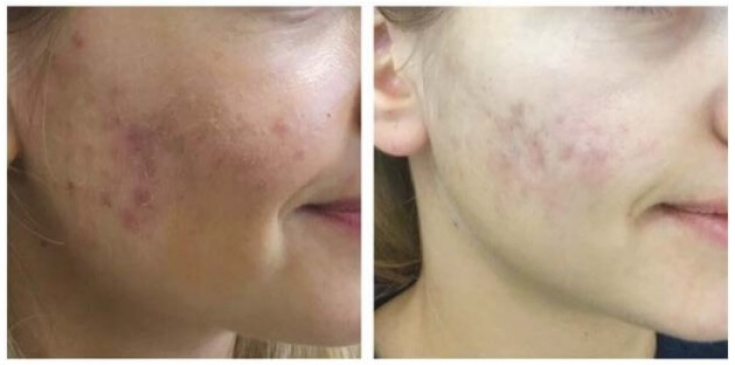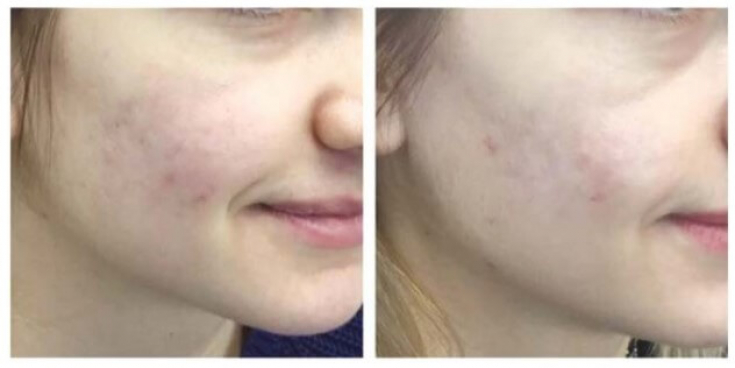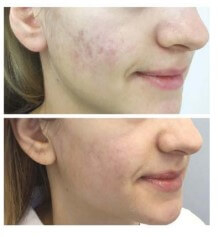There are many options for acne scar treatment which may include:
- preparations for external use;
- dermabrasion;
- laser resurfacing;
- non-ablative and fractional laser;
- chemical peels;
- use of fillers;
- microneedling etc.
With such a variety of therapies available, both the evidence of efficacy and the safety profile need to be considered when deciding which treatment is appropriate for the patient.
Dr. Adrian Baker shared his secrets of dealing with acne scars. Read about his own post-acne treatment protocol at estet-portal.com at this article.
- Post-Acne Treatment: The Unique Possibilities of Microneedling
- Acne Treatment: CellRenew Microneedling Protocol
- Clinical case: CellRenew Microneedlin protocol experienceg
The ideal treatment for acne scars is to maintain
the integrity of the epidermis while promoting the normal synthesis of collagen and elastin structures in the dermis.
Procedures that disrupt the integrity of the epidermis, such as ablative laser resurfacing and deep peels, can lead to adverse reactions such as hyperpigmentation or scarring.
Laser skin dermabrasion: an effective procedure for a young and attractive face
From this point of view,microneedle therapy is ideal for treating post-acne, as the needles penetrate deep into the dermis without damaging the epidermis.
When the needle penetrates, microchannels are formed, in which, in response to damage, acascade of inflammatory reactions is triggered:
- stem cells located inside the dermal papilla are activated;
- platelets and neutrophils are recruited to release growth factors TGF-alpha, TGF-beta and platelet-derived growth factor (PDGF);
- activates the synthesis of collagen and elastin in the papillary dermis.
fibrous type III collagen that forms in the scar tissue, replacing it over time with a collagen type I.
A 2016 study found microneedling to be the safest, most effective, and cost-effective treatment for post-acne.Read the most interesting articles in Telegram!
Post-Acne Treatment: CellRenew Microneedling ProtocolDr. Adrian Baker has developed his own clinical protocol for the treatment of acne scars under the name
CellRenew Microneedling.
Using a combination of mild enzyme peel, automatic microneedling with a special stem cell cream, and completing the treatment with post-procedure LED therapy, the specialist saw a noticeable improvement in the results of post-acne therapy.In addition to this, the doctor was able to
reduce the required number of procedures. This made it possible to make post-acne treatmentfaster and more cost-effective.
A 24-year-old woman came to the clinic and reported that she had suffered from acne since her teenage years, however, she considered acne scars to be the main problem, and she wanted to eliminate them. At the time of examination, she still had rashes on her cheeks and forehead.It is extremely important to treat acne early to prevent scarring.
For six weeks, the patient was given topical
retinol 1%, salicylic acid 2%, gentle cleanser and UV protection.
After the improvement of the clinical picture, the doctor continued the treatment for another 6 weeks.
At the end of 12 weeks, active inflammatory elements disappeared in the patient, so it was possible to proceed toelimination of post-acne scars
.

Acne before treatment and 12 weeks after topical therapy Before starting the CellRenew Microneedling
protocol, the clinician cleansed the skin and then applied theAlumierMD Enzyme Texturing Peel for five minutes. The purpose of this aspect of the treatment was to prepare the skin for the application of Calecim Professional
Stem Cell Cream during and after microneedling.Read also:
Natural cosmetic ingredients: Essential oilsAfter the enzyme peel, a thick layer of LMX4
local anesthetic cream was applied for 20 minutes, then half of the LMX4 was removed from one side of the face andClinisept +. The entire area was treated with a microneedling device at a depth of 0.5 - 1 mm.
During and after the procedure, the doctor applied Calecim Professionalstem cell product
.

Images shown after first and second CellRenew Microneedling sessions, which took place six weeks apart.

Result Six Weeks After Third Treatment Based on CellRenew Microneedling Protocol. The next step in the procedure was to treat the patient's skin with the SlimFit
LED mask using a combination of red, blue and infrared LEDs at 415nm, 630nm and 830nm for 20 minutes.This dual therapy provides an antibacterial (blue light) effect, stimulates fibroblasts (red light), and heals wounds (infrared light).
Six weeks after the thirdCellRenew Microneedling
course, the patient was delighted with the results.During the entire course of treatment, there were no complications, with the exception of short-term erythema for one to two days.
The patient is recommended to undergopreventive treatment
once a year to consolidate the results of therapy.Adapted from A
esthetics Journal.
Post-acne treatment with fillers







Add a comment